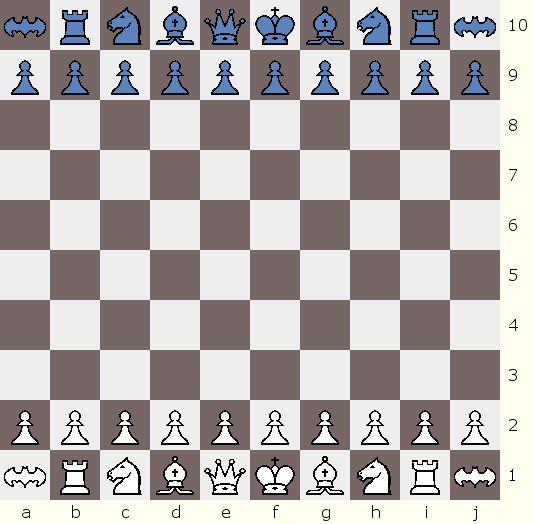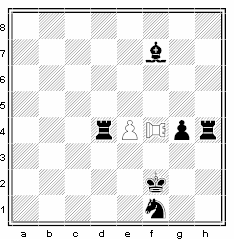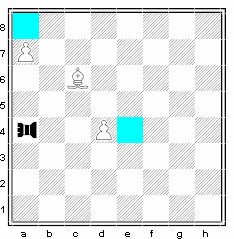Flying Bombers Grand Chess - Fly over the enemy and destroy!
In this minimalist design, the usual Chessmen are harmoniously complimented by Flying Bombers - a pair of pieces with dual range capabilities that eliminate the enemy by flying over!A triumph for the game design motif "Less is more", Flying Bombers Grand Chess features a pair of new exceptionally unique and versatile pieces. The flying bombers can double as both defensive short range fighting pieces and dangerous long range weapons. These pieces, together with the large 10X10 board are certain to enhance the strategy and tactics of the game.
This game has been updated to now include Fast Ninja Pawns instead of regular pawns.
 |
Start Position for white. (black mirrors white)
flying bombers on a1, j1 Rooks on b1,i1 knights on c1,h1 bishops on d1, g1 queen on e1 king on f1 |
The Bird’s (Flying Bomber’s) Moves
*The flying bomber's shape resembles a bat, hence the iconographic symbols used. However, the flying bomber is also referred to as the "Bird" - a common nickname given to fighter planes. The choice of name is left to the player.
The flying bomber's odd combination of long-range and short-range moves makes it a deadly weapon against an unsuspecting opponent.
Standard Move:- The flying bomber eliminates an enemy piece by flying over it, and landing on THE empty square immediately after it on the same orthogonal line. It cannot fly over or capture a second piece or land on any square beyond the first empty square.
- The flying bomber can fly along any amount of empty squares (1-9) orthogonally, but not over any friendly pieces. This is identical to the movement of a rook.
Special Move: the Helicopter Landing
This is a special maneuver that enables the bird to fly over the adjacent square, (jumping over, if occupied by friendly piece or eliminating if occupied by enemy piece) and land like a helicopter on a square exactly 2 squares away, capturing if possible on this square. It can capture two pieces in this manner.Essentially, it combines its standard move with that of a two space orthogonal jumper.
This peculiar short-range prowess in more detail:
- The Flying Bomber can fly over one friendly piece adjacent to it (left, right, up or down) and land on an empty square immediately after it. When it flies over an adjacent friendly piece, its range is limited to two squares.
- If an enemy piece is exactly 2 squares away orthogonally and no other piece is in-between, then the flying bomber can capture the usual way by flying over it and landing on the empty square after it. It can also capture by landing on the same square as the enemy.
- If two enemy pieces lie on the same line, the first one adjacent to the flying bomber, and the next two squares away, then it can eliminate both pieces by landing on the square of the second enemy piece. (see diagram 1) It cannot fly over the second enemy piece.
- Similarly, if there was a friendly piece in immediate vicinity of the flying bomber, and an enemy piece right after it, then the bird can fly over the friendly piece and destroy the piece right after by landing on the same square. Here too it cannot fly over beyond the enemy piece as it cannot fly over two pieces.
- The Flying Bomber needs at least one square to fly over for a bombing. e.g. it can destroy any enemy piece in its vicinity (1 square to left, right, up or down) by flying over it and landing on the empty square after it, but if a friendly piece occupies a square immediately after the enemy piece, no capture can be made. (see diag 2)
- It must capture the enemy piece it jumps over. (capturing is not optional).
It is easier to remember the flying bomber moves as a combination of the standard move with the move of the Dabbabah - a leaping move two squares in any orthogonal direction.
 diag 1 (sideways rook rep. flying bomber) |
Diag. 1: The flying bomber on f4 is posing multiple threats to black's pieces.
It is threatening to destroy the black bishop on f7 by moving f4-f8. Using its special 2 square helicopter capability, it is threatening the black rook on d4 by moving f4-d4 (flying over its own piece and bombing/landing on d4). It cannot land on any squares beyond d4. This same short-range prowess gives it the ability to threaten f4-h4, flying over and bombing pawn on g4 and landing/bombing rook on h4. Note that the bomber cannot move to g4 by capturing the pawn, it must eliminate both the pawn and the rook. If there was no rook on h4 then the bomber can just capture the pawn by moving f4-h4. Note that the bird IS giving check to the king because it is exactly 2 squares away, and the bird can land on f2. However the bird is not threatening the knight on f1 since it is more than 2 squares away and there is no empty square beyond it. If the king moves, the knight will not be under attack either. |
 diag 2 (sideways rook rep. flying bomber) |
Diag 2: Here the Flying Bomber is hampered by Black’s Pieces.
It is not checking the king at d7 because there is no empty square behind it (and it is not exactly 2 squares away from it). The rook on d8 is pinned, because moving it would enable the king to be captured. However, the king can simply move away and the rook on d8 is not threatened because there is no empty square beyond it. The rook on e4 is adjacent to the flying bomber and threatening it. But the Flying Bomber cannot do anything because the white pawn occupies f4 and the bomber needs an empty square after its target. If f4 was an empty square, the bomber could capture the rook, and if there was another enemy piece on f4 instead of the white pawn, then the bomber could have captured both pieces. The Flying Bomber does attack the pawn on d2. It can fly d4-d1 OR move d4-d2 to eliminate the pawn. Because it is 2 squares away, the bomber can land on the same square as its target. |
 diag 3 (sideways rook rep. flying bomber) |
Diag 3:
Here the black Flying Bomber is threatening white’s pawns at d4 and a7.
However, the white bishop is defending both pawns (colored squares). To make matters worse the bishop is also attacking the bird! |
For simplicity, the above diagrams showed a standard 8x8 chessboard, and not the actual 10X10 board space used by Flying Bombers Grand Chess.
Rules
The rules in Flying Bombers Grand Chess are the same as in chess except for the following modifications :-
Castling:
Unlike standard Chess, castling is flexible with the king able to travel 1, 2, 3, or 4 squares towards the rook.
There are 7 possible castling positions, the most extreme wing castling involves the king relocating to the b or i file. The choice of castling positions will depend on whether it is immediately necessary for the king to be tucked away at the wing or for the rook to be centralized.
The usual castling criteria apply: No piece can occupy the spaces travelled by the king and castling rook. Cannot castle out of check. King cannot pass over or land on squares attacked by enemy, but rook can.-
1 space transposition - King Side Castling
White moves King one space from f1-g1 and rook from i1-f1
Black moves King one space from f10-g10 and rook from i10-f10 -
1 space transposition - Queen Side Castling
White moves King one space from f1-e1 and rook from b1-f1
Black moves King one space from f10-e10 and rook from b10-f10 -
2 space transposition - King Side Castling
White moves King two spaces from f1-h1 and rook from i1-g1
Black moves King two spaces from f10-h10 and rook from i10-g10 -
2 space transposition - Queen Side Castling
White moves King two spaces from f1-d1 and rook from b1-e1
Black moves King two spaces from f10-d10 and rook from b10-e10 -
3 space transposition - King Side Castling
White moves King three spaces from f1-i1 and rook from i1-h1
Black moves King three spaces from f10-i10 and rook from i10-h10 -
3 space transposition - Queen Side Castling
White moves King three spaces from f1-c1 and rook from b1-d1
Black moves King three spaces from f10-c10 and rook from b10-d10 -
4 space transposition - Queen Side Castling
White moves King four spaces from f1-b1 and rook from b1-c1
Black moves King four spaces from f10-b10 and rook from b10-c10
Any other piece can occupy j1, j10, a10 or a1 during castling. -
1 space transposition - King Side Castling
-
Pawn Movement ():
The pawn can move from its original position either 1, 2 or 3 vacant squares forward.
A pawn, which initially moved forward 1 square or captured from its starting position, can subsequently at any time move forward 1 or 2 vacant squares. Once it reaches the center of the board (rank 5 for white, rank 6 for black), it can move forward only one square at a time.
Some examples: the white pawn at f2 can start f2-f5 or it can move f2-f4 then f4-f5, or f2-f3 followed by f3-f5, or move f2-g3 to capture enemy piece at g3 followed by g3-g5 next time it moves. - En Passant: If a Pawn moves two or three squares initially and passes an enemy Pawn on the
4th or 5th rank, it may be captured en passant by the enemy pawn.
E.g. White pawn on a2 black pawn on b4. White pawn moves a2 - a4 (or a5), black pawn on b4 can capture it as if it had moved to a3.
Similarly, black pawn on b5 and white pawn moves a2 - a5, then black pawn can capture the white pawn as if it moved to a4. Note in this case the white pawn can still avoid the black pawn by moving to a3 instead.
If a pawn slides forward 2 squares on its second move, it can also be captured en passant by an opposing pawn on the fifth rank. E.g. white pawn on a3 and black pawn on b5. White plays a3-a5, black pawn on b5 can capture the pawn en passant by moving to a4.
Capturing en passant is optional unless it is the only legal move available. The capture must be made on the next move. - Pawn promotion: Pawns can now promote to: queen, bishop, knight, rook or flying bomber on the 10th rank only.
Strategical Considerations
- Endgame: During the endgame, flying bombers sometimes work better than rooks against pawns. The short range double capture/leaping powers of the Flying Bomber can poses a serious threat to pawns, so the side with more pawns needs to be cautious, and perhaps attempt to exchange off the flying bombers.
- Ability to Checkmate: The flying bomber with the aid of the king still cannot checkmate a lone king It cannot check the king at the edge of the board unless it is two squares away. There are some situations where it could mate but it cannot be forced.
-
Relative Value:
The value of the flying bomber relative to the rook is hard to determine, but as a general rule, the rook is a bit more
powerful than the flying bomber whose action can be easily blocked.
An approximate set of values:
Knight=3 pawns
Bishop=4 pawns
Flying Bomber=5pawns.
Rook=6pawns
Queen=11 pawns.
- Knight vs Bishop: Because of the larger board, exchanging a bishop for a knight (if not using the super jump knight) is definitely losing the exchange, though there are cases where the knight is at least as powerful as the bishop.
Optional Subvariation: Super Power Flying Bomber
In this variation, the flying bomber moves exactly as described for the helicopter/leaping moves, but its standard move is slightly different. The bird can land on ANY square after the enemy piece, instead of the square immediately after. This means, the bird is much harder to defend against.click here for more info
Optional Variation: Super Jump Knights
It is possible to play with knights that possess an extended leap (a 3,1 jump move) in addition to their regular move i.e. the knight can also move 3 steps orthogonally and 1 step perpendicular.In this variation, the roles are reversed since the knights can be more powerful than the bishops for the duration of the game, though on an empty board the bishops can be at least equal because of their improved mobility.
In this variation, white's first move: c1-d4 threatens mate by d4-e5. But e2-e5 or h10-g8 prevents it.
Play the Game!
Play a game of Flying Bombers Chess!Click on the view button to see the beginning of a sample game.
|
If you would like to email the chess variant inventor directly: inventor@chess.computerwebservices.net
|
|
Posted by: Fly on 2012-09-14 06:41:04 Like Chess: YES I like to fly on this bomber Posted by: lizzy on 2008-11-19 12:17:41 Like Chess: YES I love the game flying bomers chess I played it ever sence Iwas little my dad tought it to me Posted by: matt on 2008-09-30 01:32:41 Like Chess: YES you are fukin shit Posted by: Anand Fan on 2007-09-14 18:34:01 Like Chess: YES
I really wish they would play this game for the world championship instead! No opening theory, all tactics and strategy! Agreed, that Omega Chess is the commercial variant with best promise. |

